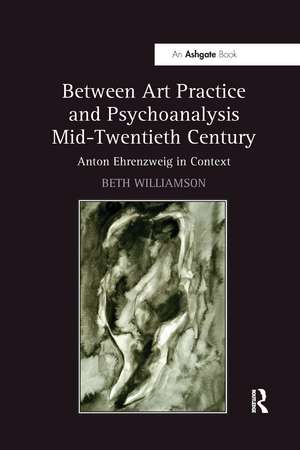Between Art Practice and Psychoanalysis Mid-Twentieth Century: Anton Ehrenzweig in Context
Autor Beth Williamsonen Limba Engleză Paperback – 18 dec 2020
Preț: 259.80 lei
Preț vechi: 311.33 lei
-17% Nou
Puncte Express: 390
Preț estimativ în valută:
49.72€ • 51.59$ • 41.56£
49.72€ • 51.59$ • 41.56£
Carte tipărită la comandă
Livrare economică 17-31 martie
Preluare comenzi: 021 569.72.76
Specificații
ISBN-13: 9780367738402
ISBN-10: 0367738406
Pagini: 240
Dimensiuni: 156 x 234 x 16 mm
Greutate: 0.44 kg
Ediția:1
Editura: Taylor & Francis
Colecția Routledge
Locul publicării:Oxford, United Kingdom
ISBN-10: 0367738406
Pagini: 240
Dimensiuni: 156 x 234 x 16 mm
Greutate: 0.44 kg
Ediția:1
Editura: Taylor & Francis
Colecția Routledge
Locul publicării:Oxford, United Kingdom
Cuprins
Contents: Introduction: Art, death and creativity; Kleinian aesthetics: (devouring) this brutal world; Adrian Stokes and Kleinian art criticism; Marion Milner: dialogues between art and psychoanalysis; Eduardo Paolozzi: a different way of looking; On not being able to teach; Bridget Riley and the dynamics of perception; The Hidden Order of Art; Robert Smithson and Robert Morris: the hidden order of process art; Conclusion: art and creativity; Appendix; Bibliography; Index.
Notă biografică
Beth Williamson is a writer and researcher based in London. From 2009 until 2014 she was a Research Fellow at Tate.
Recenzii
'Between Art Practice and Psychoanalysis offers a much-needed introduction to the work of Anton Ehrenzweig. Williamson, who has researched her subject deeply, situates his writing in relation to Melanie Klein, Marion Milner and Adrian Stokes and draws out the importance of his collaborative relationship with the artist, Eduardo Paolozzi. Ehrenzweig‘s influential book, The Hidden Order of Art, can now be read with far greater understanding, thanks to this excellent study.' Margaret Iversen, University of Essex
Descriere
The work of art theorist Anton Ehrenzweig is explored in this original and timely study. An analysis of the dynamic and invigorating intellectual influences, institutional framework and legacy of his work, this book uses previously unexamined archival material and unseen artworks to reveal the context within which Ehrenzweig worked, and how that in
